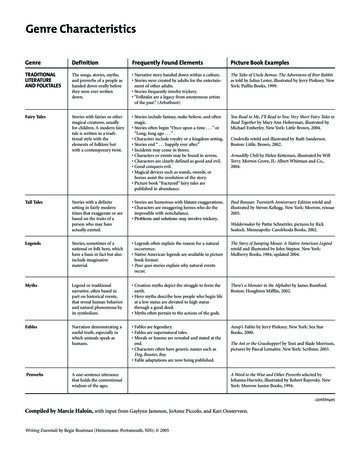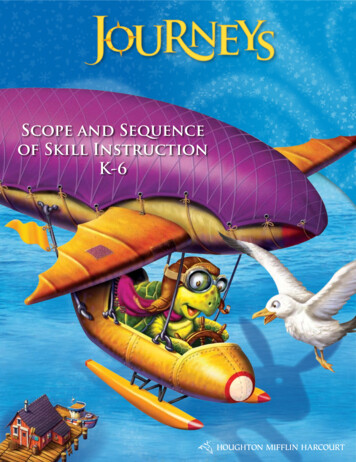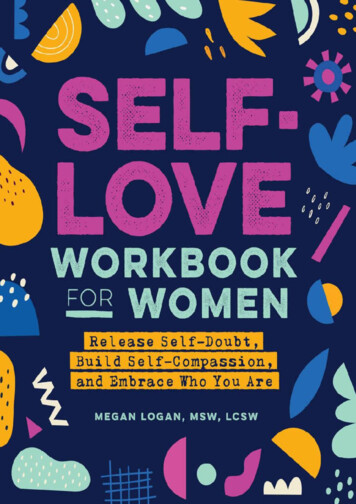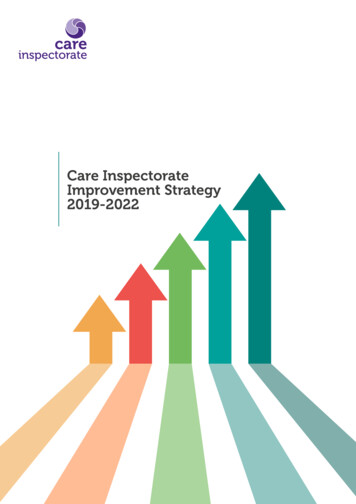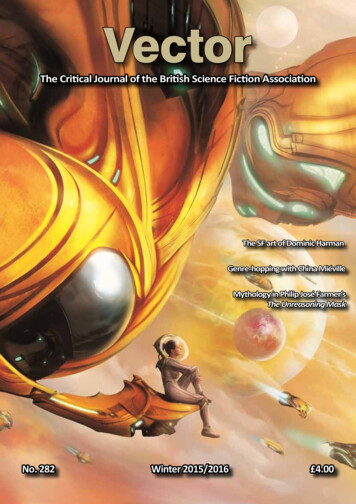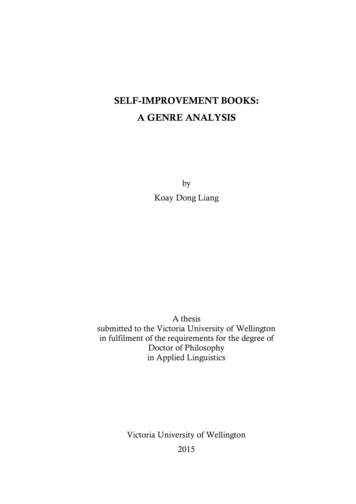
Transcription
SELF-IMPROVEMENT BOOKS:A GENRE ANALYSISbyKoay Dong LiangA thesissubmitted to the Victoria University of Wellingtonin fulfilment of the requirements for the degree ofDoctor of Philosophyin Applied LinguisticsVictoria University of Wellington2015i
ii
To the memory of my late grandmother, Lim Chai Siew, for your sacrificial loveTo my mother, Tan Yeap Wah, who taught me how to hold a pencilAnd to my sister, Ruby Koay, for all the wonderful childhood memoriesiii
iv
AbstractThe aim of the thesis is to explore the characteristics of self-improvement books as agenre. Although self-improvement books are a widely read genre, particularly in theWestern world, none to my knowledge has examined the linguistic features of this genrein detail.The thesis draws on the three main schools of genre theory: English for SpecificPurposes, Systemic Functional Linguistics, and the New Rhetoric, and begins byinvestigating the sections (e.g., acknowledgement, introduction chapter) in selfimprovement books and the typicality of the sections. Focusing on three sections:introduction chapters, body chapters, and about the author sections, the thesis examineshow authors structure the sections by analysing the moves and steps. This study alsoexamines the stories in self-improvement books by analysing the purpose of the storiesand their structure. Stories were chosen because they seemed to be a feature of selfimprovement books based on my observation and as suggested by interview data. Toanalyse self-improvement books at a register level, the thesis examines the mostunambiguous aspects of engagement: personal pronouns focusing on you, imperativeclauses, and questions. It also examines the lexicogrammatical features of selfimprovement book titles and compares them to the titles of historical biographies,showing that imperative clauses and ing-clause are found only in self-improvement booktitles. Drawing on interview data and literature on the American Dream, Americanindividualism, Neoliberalism, and New Age beliefs, the thesis explains how the linguisticcharacteristics of the genre of self-improvement books reflect these ideologies.The dataset for the study is 40 self-improvement books, selected on the basis of a set ofcriteria that I developed. Subsets were selected from the main dataset for specificanalyses. The text analysis part of the study is supplemented by interview data fromspecialist informants, who come from three categories: readers of the genre, non-readersof the genre, and authors of the genre.Move analysis identifies obligatory rhetorical moves and indicates that the main purposesof introduction chapters and about the author sections are persuading readers to read thebook, and establishing credibility, respectively. Authors always persuade readers to readtheir books by listing reasons to read them. To demonstrate authors’ credibility, they referv
to their areas of expertise. Unlike the introduction chapters and about the author sections,the body chapters have more than one obligatory rhetorical move. The body chapterspresent the problem that readers potentially experience, present the authors’ message,recommend practical applications, and encourage readers to apply them. From a genreperspective, the purpose of all the stories in my analysis is to illustrate the authors’message.Register analysis, and drawing on interview data, suggests that authors use the personalpronoun you, imperative clauses, and questions to engage readers. The abundance of thepersonal pronoun you suggests that self-improvement books are a reader-oriented genre.The analysis of the imperative clauses using Halliday’s process types suggests that themain way to improve our lives, the authors recommend, is to change how we think.Finally, my thesis shows that the social purpose of self-improvement books is to helppotential readers improve their lives, and the approach of improving one’s life has anindividualistic orientation.vi
Acknowledgements“Whenever I am afraid, I will trust in You.”Psalm 56:3 NKJVFirstly, I would like to thank the Lord for His faithfulness and providence in this PhDjourney.I am deeply grateful to have Dr Jean Parkinson and Dr Elaine Vine as my supervisors. Iwould like to thank them for the time they spent on reading and commenting on thedrafts of this thesis, and the fortnightly meetings we had for the past three and a halfyears. They have taught me valuable lessons of life: the importance of reflection, thevalue of humility, and “this is not a perfect world.” They reminded me that writing upthe thesis is ideally not the “ultimate” goal of a PhD, rather it is what I have learned inthe process.I would like to acknowledge my research participants for their time and insights. I wouldlike to particularly thank the self-improvement authors in America who willinglyparticipated in the Skype interview despite the time zone difference.I would like to thank Victoria University of Wellington who generously funded mystudies with the Victoria Doctoral Scholarship. I would also like to thank the School ofLinguistics and Applied Language Studies for providing a supportive environment. Mythanks go to Associate Professor Meredith Marra for bouncing ideas with me. Thanks tomy officemate, Jay Woodhams, for the engaging discussions we had, both academic andnon-academic, and for the weekly squash sessions at the court. I would like to thank DrKieran File for discussing the concept of genre with me at the initial stage of my study,and Dr Jackie Yeoh for encouraging me when I am doubtful of my ability. I would alsolike to thank Kirsten Reid from Student Learning for being a sounding board.I would not have pursued this degree without the encouragement of my Master’sresearch supervisor, Associate Professor Mohamad Hassan Zakaria.vii
I would also like to acknowledge and thank my examiners - Professor John Swales, DrIan Bruce and Dr Keith Comer - for reading my thesis and providing insightfulcomments.Thanks also to Nick Field for your prayers and friendship. I would especially thank avery special friend, Mark Moore, for being a father figure to me. I would also like tothank George and Irene Ross for being my New Zealand family, and to Jude Murdochfor taking interest in my study and providing an outsider’s perspective. I would like tothank Rev. Allister Lane for accepting me as I am and praying for me when my worldseems confusing. I would also like to thank my friends who were with me through theups and downs of my PhD journey: Stephen Caughley, Benjamin Ching, David Jones,Pakjira Leelertphan, Douglas Meyer, Alvin Ngai, Alyssa Ong, Will Quinn, Allen Xu,and those whose names are not mentioned here.I would like to thank my students, particularly my choir students in Malaysia, forenriching my life; to Tan Seoah Chee and Wan Nor Maizan Wan Ismail for being verysupportive colleagues in Malaysia; and to Lee Ai Leng for supporting my decision tofurther my studies.Finally, I would like to specially thank my mother, Tan Yeap Wah, for believing in mydreams and constantly praying for me; to my sister, Ruby Koay, for keeping me updatedwith mum’s health; and Aunty Lian Choo for keeping mum company while I was away.I am grateful to my away-from-home family, Ooi Yew Chai, Loh Bee Gek, Ooi ShawYang, Ooi Lih Yang and Ooi Kaylene for their Facebook messages that kept me going.viii
ContentsList of tables . xvList of figures. xviiIntroduction . 11.1Background of the study . 11.2Aims of the study. 21.3Thesis overview . 3Literature review . 52.1Self-improvement books . 52.2Genre theory . 7Genre . 8Traditions of genre studies. 10Moves and steps. 13Obligatory, typical and optional moves . 16Organisation of moves . 18Move structure . 19Overall structure . 20Rhetorical structure . 20Typical organisation of moves . 22Schematic structure. 22Distinctive structural pattern . 23Generic structure . 24Move analysis . 252.3Reader-response theory . 272.4Persuasion . 28ix
Credibility .30Engagement .32Reader pronouns .34Directives.36Questions.382.5Ideology and self-improvement books .40Definition of ideology.40The American Dream .42American individualism .45Neoliberalism .46New Age beliefs .472.6Summary of chapter .48Research design and methodology .513.1Research design .513.2Identifying self-improvement books .533.3Analysing the sections in self-improvement books .573.4Interviewing authors .593.5Interviewing readers and non-readers.603.6Ethical considerations and copyright issues .623.7Summary of chapter .64Analysis of interview data.654.1Themes in author interview data .65Descriptions of target readers .66The process of changing one’s life .67The purpose of writing.68Author’s identity .70The style of writing .71x
4.2Themes in reader and non-reader interview data . 72Common labelling of the genre . 72Changing and improving reader’s life . 73Aspects of life . 74Repetitive character of the message. 75Individualistic approach . 76Accessible style of language . 76How readers read self-improvement books . 774.3Summary of chapter. 77Genre analysis . 795.1Sections in self-improvement books . 795.2Moves in introduction chapters . 1005.3Moves in body chapters . 1285.4Moves in about the author section . 1565.5Stories . 176Stories and storytelling . 176Recount. 179Anecdote . 181Exemplum. 182Observation . 183Narrative . 184Analysis of stories . 186Analysis of exemplums . 188Analysis of narrative structure . 1915.6Summary of chapter. 199Register analysis . 2036.1Personal pronouns . 203xi
Comparing frequencies of you across genres . 205Grammatical positions of you. 208Collocates of your . 209Verbs that connect with your life . 213Your life in the subject position . 215Your life in the object position . 2166.2Directives in the imperative form . 2196.3Functions of questions. 2286.4Modality . 2426.5Lexicogrammar of self-improvement book titles . 252Lengths of titles, head titles and subtitles . 254Lexicogrammar of titles . 262The field of titles . 262Your life in titles . 263Grammatical structure of head titles . 2666.6Summary of chapter . 270Discussion . 2737.1The purpose of self-improvement books . 2747.2Areas of improvement in self-improvement books . 2787.3The self in self-improvement books . 2797.4Authors’ recommendations . 2827.5Persuasion . 284Constructing a credible persona . 284Engaging readers . 288Reader pronouns . 288Directives in the imperative form . 289Questions. 290xii
Aphorisms and pull-quotes. 291Stories . 2927.6Author-reader relationship . 2947.7Summary of chapter. 298Conclusion . 3018.1Findings summary . 302Findings summary for RQ1 . 302Findings summary for RQ2 . 303Findings summary for RQ3 and RQ4 . 3038.2Methodological contributions. 304Non-readers of self-improvement books as informants. 304Recruitment of interview participants . 305Identifying readers/non-readers of self-improvement books . 3078.3Theoretical contributions . 307Are narratives a genre? . 308Extending Hyland’s system of engagement – stories . 309Analysing steps to understand a culture . 310Behavioural process and existential process . 3118.4Practical applications . 312A resource for new self-improvement book authors . 312Language teaching applications . 312Engaging and reader-oriented. 313Authentic material . 314Opportunities for critical reflection . 314Teaching material evaluation . 3158.5Limitations and future research . 3168.6Closing remarks . 317xiii
Appendices . 319Appendix 1: List of books in the main dataset. 319Appendix 2: Examples of interview questions (author). 321Appendix 3: Examples of interview questions (reader/non-reader) . 322Appendix 4: Reader/non-reader interviewee recruitment advertisement . 323Appendix 5: Ethics approval memorandum . 324Appendix 6: Information sheets and letter of consent . 325Appendix 7: Copyright permissions letter . 328References . 329Primary Sources . 351xiv
List of tablesTable 1: A move and related steps in research articles . 15Table 2: Characteristics of self-improvement books . 54Table 3: Characteristics of eliminated books . 56Table 4: Prototypical arrangement of sections in self-improvement books . 80Table 5: Sections in self-improvement books according to frequency . 98Table 6: Moves and Steps in introduction chapters . 118Table 7: Example of full introduction chapter . 121Table 8: Moves and steps in body chapters . 142Table 9: Example of full body chapter . 144Table 10: Moves and steps in about the author section . 170Table 11: Example of full about the author section . 168Table 12: Storytelling genres . 178Table 13: Occurrence of stories . 186Table 14: Occurrences of storytelling genres . 188Table 15: Complete example of exemplum . 189Table 16: Moves in exempla . 191Table 17: Occurrence of stories with complication-resolution structure . 192Table 18: Complete example of story with complication-resolution structure . 192Table 19: Moves in narratives . 197Table 20: Most frequent words in 20 self-improvement books (1,327,500 word tokens) 205Table 21: Comparison of you frequencies . 206Table 22: Comparison of grammatical positions of you in self-improvement books and jobadvertisements . 208Table 23: Collocates of your in 20 self-improvement books (1,327,500 word tokens) . 210Table 24: Collocations of your after grouping . 211Table 25: Comparing grammatical positions of your life and you . 214Table 26: Verbs that frequently govern your life . 216Table 27: Frequency of directive in the imperative form . 220Table 28: Frequency of imperative clauses in various genres . 220Table 29: Distribution of process types in six self-improvement books . 225Table 30: Number of questions per 10,000 words in five self-improvement books . 230xv
Table 31: Number of questions per 10,000 words in various genres . 231Table 32: Distribution of question functions in five self-improvement books . 240Table 33: Frequency of questions with reader pronoun . 241Table 34: Modality according to Biber et al. (1999) . 243Table 35: Number of high and low modality elements per 180 turns . 246Table 36: Collective frequency of modal verbs. 248Table 37: Frequency of modal verbs in individual chapters . 249Table 38: Frequencies of occurrence of lengths of titles, head titles and subtitles of selfimprovement books . 255Table 39: Length of titles (self-improvement books) . 256Table 40: Length of head titles (self-improvement books) . 256Table 41: Length of subtitles of self-improvement books . 257Table 42: Frequencies of occurrence of lengths of titles, head titles and subtitles ofhistorical biographies . 258Table 43: Length of titles of historical biographies . 258Table 44: Length of head titles of historical biographies . 259Table 45: Length of subtitles of historical biographies . 259Table 46: Comparing self-improvement books and historical biographies . 260Table 47: Mean lengths of complex titles of self-improvement books and journal articles. 261Table 48: Distribution of complex titles. 261Table 49: Word frequency list of self-improvement book titles . 263Table 50: Grammatical structures of self-improvement book head titles . 268Table 51: Grammatical structure of historical biography head titles . 268Table 52: Grammatical comparison of head titles of self-improvement book and historicalbiography . 269xvi
List of figuresFigure 1: Example of title page with quote . 81Figure 2: Example of title page verso . 82Figure 3: Example of praise from others . 84Figure 4: Quote . 86Figure 5: Contents page . 87Figure 6: Affirmative statements . 88Figure 7: Foreword . 89Figure 8: Preface. 90Figure 9: Introduction . 92Figure 10: Conclusion. 93Figure 11: Advertisement . 96Figure 12: Introduction . 102Figure 13: Heading . 130Figure 14: Subheading . 132Figure 15: Pull-quote . 138Figure 16: About the author . 158Figure 17: Social action vs. private intention. 275xvii
1
IntroductionThis chapter presents the background of the study through a brief account of my teachingexperience in a Malaysian secondary school, and how that teaching experience led me tostudy self-improvement books as a genre. It then introduces the aims of this thesis, andthe research questions that this thesis addresses. It concludes with an overview of thethesis.1.1 Background of the studyTeaching has always been my passion and I am most satisfied when I see adolescentsgrowing up to discover their potential and when I can contribute to their individualjourney of discovery. During my seven years of teaching a wide range of secondaryschool students in Malaysia, from highly reluctant to highly motivated ones and from alower English proficiency group to a higher English proficiency group, self-improvementbooks (commonly known a
improvement books and the typicality of the sections. Focusing on three sections: introduction chapters, body chapters, and about the author sections, the thesis examines how authors structure the sections by analysing the moves and steps. This study also examines the stories in self-improvement books by analysing the purpose of the stories
